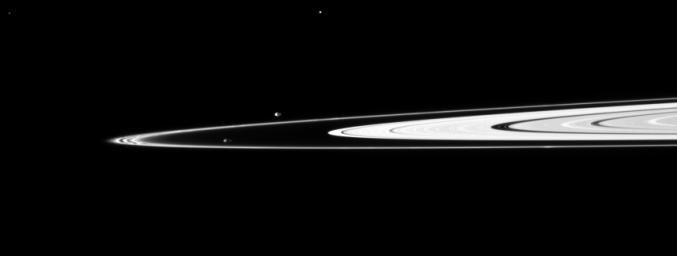
|
Potato Pair
- Click the image above for a larger view
- Full-Res JPEG (860 x 325) (10.0 kB)
- Full-Res TIFF (860 x 325) (280.0 kB)
Caption:
Pandora and Prometheus, the shepherding moons of the F ring, orbit inside and outside the thin ring.
The elongated, potato-like shapes of the two moons are both visible here. Pandora (81 kilometers, or 50 miles across) orbits outside the F ring and, with the inner shepherd moon Prometheus, helps to keep the narrow lanes of the F ring in check. The gravity of Prometheus (86 kilometers, or 53 miles across) periodically creates the streamer-channels in the F ring. See PIA08397 to learn more. The bright specks at the top center and top left of the image are background stars.
This view looks toward the northern, sunlit side of the rings from just above the ringplane.
The image was taken in visible light with the Cassini spacecraft narrow-angle camera on Nov. 28, 2009. The view was acquired at a distance of approximately 2.5 million kilometers (1.6 million miles) from Pandora. Prometheus is 2.4 million kilometers (1.5 million miles) away. Scale on Pandora is 15 kilometers (9 miles) per pixel.
Background Info:
The Cassini-Huygens mission is a cooperative project of NASA, the European Space Agency and the Italian Space Agency. The Jet Propulsion Laboratory, a division of the California Institute of Technology in Pasadena, manages the mission for NASA's Science Mission Directorate, Washington, D.C. The Cassini orbiter and its two onboard cameras were designed, developed and assembled at JPL. The imaging operations center is based at the Space Science Institute in Boulder, Colo.
For more information about the Cassini-Huygens mission visit http://saturn.jpl.nasa.gov/ . The Cassini imaging team homepage is at http://ciclops.org .
Cataloging Keywords:
| Name | Value | Additional Values |
|---|---|---|
| Target | Saturn Rings | |
| System | Saturn | |
| Target Type | Ring | |
| Mission | Cassini-Huygens | |
| Instrument Host | Cassini Orbiter | |
| Host Type | Orbiter | |
| Instrument | Imaging Science Subsystem (ISS) | |
| Detector | Narrow Angle Camera | |
| Extra Keywords | Grayscale, Visual | |
| Acquisition Date | ||
| Release Date | 2010-01-14 | |
| Date in Caption | 2009-11-28 | |
| Image Credit | NASA/JPL/Space Science Institute | |
| Source | photojournal.jpl.nasa.gov/catalog/PIA12527 | |
| Identifier | PIA12527 | |
